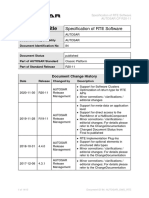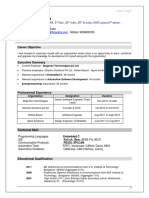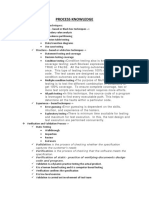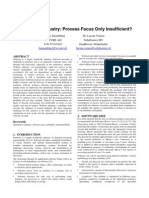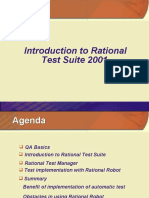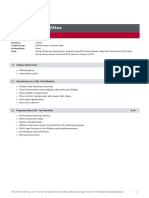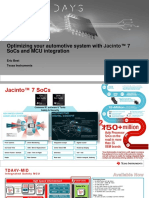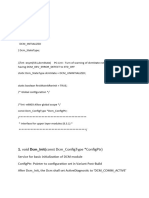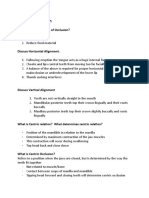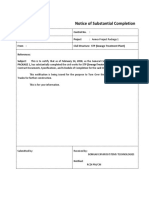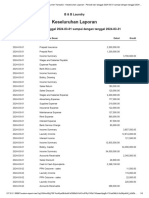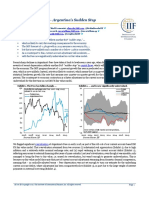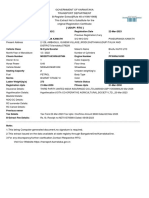Unit Testing
Unit Testing
Uploaded by
GiridharCopyright:
Available Formats
Unit Testing
Unit Testing
Uploaded by
GiridharOriginal Title
Copyright
Available Formats
Share this document
Did you find this document useful?
Is this content inappropriate?
Copyright:
Available Formats
Unit Testing
Unit Testing
Uploaded by
GiridharCopyright:
Available Formats
KPIT Technologies Ltd.
Confidential Proprietary Information
Distribution Limited
Do Not Copy Without Prior Permission
UNIT TESTING
Document Identifier: UNIT TESTING
AUTOSAR Release Referred: R4.2 Rev1
Document Version: 1.0.0
Date: 25-Jun-2015
Prepared By:
Products Group
KPIT
India
Test Strategy document for Unit, Module and Integration Testing
Document Identifier: ASRKPITBSW421_TestStrategy
Version: 1.0.0, Dated: 17-April-2015
Page: 1 of 23
KPIT Technologies Ltd. Confidential Proprietary Information
Distribution Limited
Do Not Copy Without Prior Permission
1. UNIT TESTING
Unit testing is performed to identify the deviations present in the AUTOSAR BSW modules code
with respect to design. The Unit is the smallest testable part of the software, which is a function
(API). The unit will be tested individually by providing inputs and validating the outputs from that
function. The unit testing activity goes hand by hand with development activity and unit testing will
be performed by developer.
1.1 SCOPE OF UNIT TESTING
1.1.1 SCOPE INCLUSION
To verify whether code meets the Design.
Verify 100% statement coverage (C0).
Verify 100% Path coverage.
Verify 100% Modified Condition Decision Coverage (MCDC). (C2)
Higher order coverage (Loops).
Analysis of equivalence classes
Analysis of boundary values for global variables, global pointers (Min, Mid, Max). Assumption is
that all the local variables mapped to global variables and detailed Design document should
provide the Engineering value for Global Variable.
To identify un-executable paths.
Verification of return type function calls or nested function calls
Stub details is available, while generating script in RTRT. Here, stub means function
present in other .c files of same module.
If function call or nested function calls present in the same .c file, RTRT will not provide
any details.
Manual analyzation is required and path of calling function should be covered.
Typecasting related testing are followed in unit testing but not for void.
1.1.2 SCOPE EXCLUSION
RTRT does not allow testing of assembly routines.
Overcome: Comment assembly routines while testing (Ex: __asm).
Compiler directives like #pragma.
Overcome: Comment the particular line while testing.
_ _inline are not supported by RTRT.
Overcome: Make changes in TDP Editor Path: Testing ->Parser Settings ->Runtime analysis features
for C. Here we need to add #pragma attol accept “inline".
If RTRT generates a huge executable code, then sometimes it may not be possible to debug due
Test Strategy document for Unit, Module and Integration Testing
Document Identifier: ASRKPITBSW421_TestStrategy
Version: 1.0.0, Dated: 17-April-2015
Page: 2 of 23
KPIT Technologies Ltd. Confidential Proprietary Information
Distribution Limited
Do Not Copy Without Prior Permission
to the size limit of the debugger.
Overcome: Execute the test scripts by grouping minimum number of APIs.
Array out of bound checking are not done in unit testing if it happens it will throw some
Warning (out of range) in unit testing. If warning comes, report generation cannot be done. If the
array index comes in the loop more than once, coverage will not be 100%.
Overcome: Verification has to be done manually.
1.2 INPUTS TO UNIT TESTING
TDP (Target Deployment Port):
RTRT TDP Qualification Sheet (Contains the information of compiler/compiler
flags,Debugger,Linker/Linker flags and Target).
TDP has to be selected based on the test environment.
1.3 UNIT TESTING WORK PRODUCTS
Test cases (UTP)
Test driver (script) file (PTU)
Test results file (RTR Tool generated)
Coverage report (RTRT Tool generated)
Test Summary Report (RTRT Tool generated)
Test plan report (UTR)
TR checklists (UTP & UTR)
1.4 UNIT TESTING PROCEDURE
To test each unit function, a set of input variables are passed on to the testing sub-module and the
result is compared against the expected result after executing the software in a controlled
environment.
Unit test plan approach will be as below:
Stage 1: Create Equivalence sheet & unit test plan with ESDD (HLD+LLD+Flow chart) as inputs.
Derive the functional test plan for all possible scenarios(path)
Test Strategy document for Unit, Module and Integration Testing
Document Identifier: ASRKPITBSW421_TestStrategy
Version: 1.0.0, Dated: 17-April-2015
Page: 3 of 23
KPIT Technologies Ltd. Confidential Proprietary Information
Distribution Limited
Do Not Copy Without Prior Permission
Stage 2: Update the same unit test plan once the source code is available to achieve 100%
coverage (MCDC, statement, path, loops, boundary values, equivalence class)
Dependency parameter values like global to local variable mapping
(API inputs), Function calls, Global variable updation, Return value, Stub calls
Unit testing involves the following steps:
Analysis of ESDD ( HLD + LLD + Flow Chart). & Preparation of
Euiqvalance Sheeet
Stage1: Create Unit Test Plan
Verification of ESDD with source code
Generation of configuration (K-SAR EDITOR tool)
Stage2: Update Unit Test Plan, once source code is available
Selection of the TDP (RTRT tool)
Generation of PTU file from the Source code (RTRT tool)
Execute Test scripts & Report generation (RTRT tool)
Unit Test Report Preparation
Technical Review, Screen and Store of UTP and UTR
Test Strategy document for Unit, Module and Integration Testing
Document Identifier: ASRKPITBSW421_TestStrategy
Version: 1.0.0, Dated: 17-April-2015
Page: 4 of 23
KPIT Technologies Ltd. Confidential Proprietary Information
Distribution Limited
Do Not Copy Without Prior Permission
2. MODULE TESTING (EMBEDDED)
Module testing is used to verify behaviour of the BSW module against functional requirements from
AUTOSAR <MSN> SRS. Test cases are derived for all the functional requirements for BSW module.
Different test groups shall be created based on the features.
2.1 SCOPE OF MODULE EMBEDDED TESTING
2.1.1 Scope Inclusion
100% functional requirement coverage (Requirements with category “Requirement on
Module Behaviour”).
Verification of functionality against Min – Max values for configuration parameters.
(For the max value of configuration parameter, we need to check with the integration teams
for max values/multiplicity, and after the approval from the Architect, the same need to be
used)
Verification of functionality against for all possible values for Enumeration type and Boolean
type parameters.
Verification of APIs for DET functionality to identify overflow / underflow.
2.1.2 Scope Exclusions
Performance testing, memory /timing measurement shall not covered.
2.2 INPUTS FOR MODULE EMBEDDED TESTING
KPIT AUTOSAR <MSN> SRS
Embedded source code.
Module parameter definition file (PDF)
Module tool generator (Template based generator)
2.3 MODULE TESTING WORK PRODUCTS
System Test Specification (STS) document.
Test application
Test configuration (arxml file)
Stub code files
Test report (STR) for x86 platform
Test report (STR) for porting
Test Strategy document for Unit, Module and Integration Testing
Document Identifier: ASRKPITBSW421_TestStrategy
Version: 1.0.0, Dated: 17-April-2015
Page: 5 of 23
KPIT Technologies Ltd. Confidential Proprietary Information
Distribution Limited
Do Not Copy Without Prior Permission
2.4 MODULE EMBEDDED TESTING PROCEDURE
To test each functional requirement (Requirement with category “Requirement on Module
Behaviour”), different test cases are derived. Different test cases shall be grouped based on the
similar functionality and it is termed as Test group. For 100% requirement coverage, different test
groups shall be created and each test group shall have test cases covering similar functionality.
Each test group shall have separate test configuration and Key configuration parameters shall be
identified which can impact the functionality under test. Provide Min – Max values for the key
parameters and create different set of configuration values. Each test case shall refer one of the
configuration set.
Folder structure and Make environment shall be created for the module testing with consideration
of compiler specific Generic header files. Test application shall be created for each test group. All
test cases from test group shall be covered under respective test application. Coding guideline shall
be followed while creating test application. Module Test configuration shall be created for each test
group using K-SAR tool.
Generate configuration using generation tool and build test application using generated test
configuration files. For x86 platform, Run generated executable (.exe) file and verify the result.
For porting, load executable (.out / .elf) in the debugger and run test application and verify result.
Create Test report in the STR template based on the result from the above step. If any test case is
not tested or failed, provide justification for the same.
Test Strategy document for Unit, Module and Integration Testing
Document Identifier: ASRKPITBSW421_TestStrategy
Version: 1.0.0, Dated: 17-April-2015
Page: 6 of 23
KPIT Technologies Ltd. Confidential Proprietary Information
Distribution Limited
Do Not Copy Without Prior Permission
Module testing involves the following steps:
Analyze Module SRS and Create test plan covering all requirements with category
“Requirement on Module Behavior”
Identify different Test groups based on functionalities / group of functionalities
which shall be tested using one set of configuration
Identify Key configuration parameter for each test group
For each test group, Identify Default conditions and commonly used macros which
shall be used to pass values as argument and verify out parameter
For each test case, provide unique and sequential test case id with proper title.
Provide requirement reference in “Tested functionality” and applicable
configuration set in “Configuration Test Id”
Identify precondition specific to test case and provide it in “Pre-condition”
In test description, provide test steps like invocation of module provided APIs, test
APIs and stub functions
In Expected result, verify return value, OUT parameter for the APIs invoked in test
description
Technical review and screen of module test plan document
Test Strategy document for Unit, Module and Integration Testing
Document Identifier: ASRKPITBSW421_TestStrategy
Version: 1.0.0, Dated: 17-April-2015
Page: 7 of 23
KPIT Technologies Ltd. Confidential Proprietary Information
Distribution Limited
Do Not Copy Without Prior Permission
Prepare Make environment for the module testing with consideration of compiler
specific Generic header files
Create test application based on the module test plan. Add stub code for
dependent modules. Follow coding guideline while creating test application
Create test configuration for each test group using K-SAR tool
Generate test configuration and build test application using make commands
Run test application executable (.exe/.out/.elf) using debugger
Create module test report manually as per STR template. If test case is failed or
not tested, then provide proper justification
Technical review and screen of module STR document
Figure: Module testing procedure workflow
Test Strategy document for Unit, Module and Integration Testing
Document Identifier: ASRKPITBSW421_TestStrategy
Version: 1.0.0, Dated: 17-April-2015
Page: 8 of 23
KPIT Technologies Ltd. Confidential Proprietary Information
Distribution Limited
Do Not Copy Without Prior Permission
2.5 TEST SETUP
The test environment consists of the Integrated Development Environment (IDE) for building the BSW that
has to be tested and test setup for x86 or other specified platform.
Figure: Test Setup for Module testing
Build environment for module testing consists make environment which uses Test application, Module
code, module test configuration and test stub code for building complete test group. Test applications are
developed for each test group based on the test plan and stub code shall be created for all the
dependent modules. Sample test application and stub code are provided in the example below. Test
application will invoke functions of Module under test which is provided in the test description column of
Test Strategy document for Unit, Module and Integration Testing
Document Identifier: ASRKPITBSW421_TestStrategy
Version: 1.0.0, Dated: 17-April-2015
Page: 9 of 23
KPIT Technologies Ltd. Confidential Proprietary Information
Distribution Limited
Do Not Copy Without Prior Permission
test case. Module shall invoke APIs of dependency module, so stub code shall be provided. Test
configuration and Generic header files are included in the module and shall require for building test
application.
Respective make command shall be used to build the test application. Executable shall be generated once
build is successful without any compilation or linking warning. Run executable using debugger and verify
result for all test cases covered in the test group. Create module test report based on the result from all
test groups.
Test environment used for testing on x86 platform is listed below:
Sl. No. Environment Details
1 Platform x86
2 Device id --
3 Evaluation Board name (external clock used) --
4 IDE Name and Version <MinGW Developer Studio Version 2.0.5>
5 Compiler GCC
6 Linker GCC
7 GNU Make Version 3.80
Similarly, test environment for porting shall be provided for respective platform in the porting STR .
2.6 EXAMPLE
2.6.1 Diagnostic Session Control Test Group
2.6.1.1 Test Strategy
The purpose of the test cases in this section is to test the processing of the DiagnosticSessionControl
service in different protocols by the DSP layer.
Scope of the Test Cases in this section is to check all possible functionalities which could be achieved via a
DiagnosticSessionControl service. The positive and negative response transmission by the DSP layer for
the DiagnosticSessionControl is also tested in this section.
2.6.1.2 Default Condition:
DCM Module should be fully initialized and should be in Full Communication Mode before the reception
of Request.
2.6.1.3 Key Configuration Details:
1. Configuration arxml file name: App_Dcm_DspDiagnosticSessionCtrl.arxml
2. Configuration parameters details:
Test Strategy document for Unit, Module and Integration Testing
Document Identifier: ASRKPITBSW421_TestStrategy
Version: 1.0.0, Dated: 17-April-2015
Page: 10 of 23
KPIT Technologies Ltd. Confidential Proprietary Information
Distribution Limited
Do Not Copy Without Prior Permission
2.6.1.4 Commonly used macros:
Below listed macros used for Diagnostic session control
Sl Macro Name Value Macro Description
No and its useage
1 PHY_UDS_ON_CAN_RXPDUID 0 NA
2 FUN_UDS_ON_CAN_RXPDUID 1 NA
3 UDS_ON_CAN_TXPDUID 2 NA
4 DCM_TPNSDU_LENGTH_2 2 NA
2.6.1.5 Sequence Diagram:
NA
2.6.1.6 DCM_ETC_143: Changing Session from Default To Extended Diagnostic
Session For The Protocol Id (Dcm_Uds_On_Can)
Test case ID DCM_ETC_143
Test case version: 1.0
Test case date: 11-Mar-2015
Test purpose: Requirement Test
Configuration Test Id 4
1. If the actual diagnostic session is changed into a session different
than the default session (initiated by UDS Service
DiagnosticSessionControl), the DCM shall call
ComM_DCM_ActiveDiagnostic () to inform the ComM module about
the need to stay in Full Communication Mode.
{Dcm167}
Tested functionality:
2. The sent confirmation function shall do the mode switch of the
ModeDeclarationGroupPrototype DcmDiagnosticSessionControl by
calling
SchM_Switch_Dcm_<vendorApiInfix>_DcmDiagnosticSessionControl()
with the new diagnostic session type (see Dcm778).
{Dcm311b}
Test Strategy document for Unit, Module and Integration Testing
Document Identifier: ASRKPITBSW421_TestStrategy
Version: 1.0.0, Dated: 17-April-2015
Page: 11 of 23
KPIT Technologies Ltd. Confidential Proprietary Information
Distribution Limited
Do Not Copy Without Prior Permission
Pre-conditions: None
Test description: Expected test result:
1. Dcm_StartOfReception should return
1. Invoke Dcm_StartOfReception
BUFREQ_OK
(PHY_UDS_ON_CAN_RXPDUID,
2. RxBufferSizePtr should be updated with
DCM_TPNSDU_LENGTH_2, &RxBufferSizePtr)
available buffer size as 0x08
2. Invoke Dcm_CopyRxData
(PHY_UDS_ON_CAN_RXPDUID, &PduInfoPtr, 3. Dcm_CopyRxData should return
&RxBufferSizePtr) BUFREQ_OK
4. RxBufferSizePtr should be updated with
Hint: PduInfoPtr.SduLength = 0x02 buffer size as 0x06
PduInfoPtr.SduDataPtr = 0x10, 0x03
3. Invoke Simulate_Dcm_SessionControl() with
NA
SessionLevel as 3 (Extended Session)
5. PduR_DcmTransmit(UDS_ON_CAN_TXPDUI
4. Invoke
D, &PduInfoPtr) should be invoked
Dcm_TpRxIndication(PHY_UDS_ON_CAN_RXPDUI
D, NTFRSLT_OK)
Hint: PduInfoPtr.SduLength = 0x06
6. Dcm_CopyTxData should return
5. Invoke BUFREQ_OK
Dcm_CopyTxData(UDS_ON_CAN_TXPDUID, 7. PduInfoPtr.SduDataPtr should be updated
&PduInfoPtr, NULL_PTR, &TxDataCntPtr) with the values 0x50, 0x03, 0x00, 0x32,
0x00, 0x05
Hint: PduInfoPtr.SduLength = 0x06 {DCM_SRS_006}
8. TxDataCntPtr should be updated with 0x00
9. ComM_DCM_ActiveDiagnostic(0x04) should
be invoked
6. Invoke Dcm_TpTxConfirmation {Dcm167}
(UDS_ON_CAN_TXPDUID, NTFRSLT_OK) 10. SchM_Switch_Dcm_DcmDiagnosticSessionC
ontrol(0x03) should be invoked
{Dcm311b}
11. Dcm_GetSesCtrlType should return E_OK
7. Invoke Dcm_GetSesCtrlType(&SesCtrlValue) 12. SesCtrlValue should be
0x03(EXTENDED_DIAGNOSTIC_SESSION)
Comments: None
Please refer attached test template and guideline documents for more information.
Test Strategy document for Unit, Module and Integration Testing
Document Identifier: ASRKPITBSW421_TestStrategy
Version: 1.0.0, Dated: 17-April-2015
Page: 12 of 23
KPIT Technologies Ltd. Confidential Proprietary Information
Distribution Limited
Do Not Copy Without Prior Permission
2.6.2 Test Application and dependency module stub:
Sample Test application for the above mentioned test case:
To build above test application, stub shall be provided for the dependent modules. Following example
shows the sample stub file for PduR module.
Similarly test execution is carried on for different test cases.
2.6.3 Module Embedded STR
Below is sample Module STR for Dcm module
Test Strategy document for Unit, Module and Integration Testing
Document Identifier: ASRKPITBSW421_TestStrategy
Version: 1.0.0, Dated: 17-April-2015
Page: 13 of 23
KPIT Technologies Ltd. Confidential Proprietary Information
Distribution Limited
Do Not Copy Without Prior Permission
Test Log shall be stored at separate folder and reference is provided in Test report.
Please refer Module STR template for more details.
2.7 PROPOSED ENHANCEMENT:
Automation for auto generation of Test report for all modules.
Provide solution to identify and correct test description when there is any change in sequence
diagram when it is provided.
Test Strategy document for Unit, Module and Integration Testing
Document Identifier: ASRKPITBSW421_TestStrategy
Version: 1.0.0, Dated: 17-April-2015
Page: 14 of 23
KPIT Technologies Ltd. Confidential Proprietary Information
Distribution Limited
Do Not Copy Without Prior Permission
3. MODULE TESTING (TOOL)
Purpose of module tool testing is to verify correctness of generation of configuration. It
consists verification of configuration parameters for valid range, valid multiplicity,
boundary analysis, pre-conditions for parameter configuration is verified.
3.1 SCOPE OF MODULE TOOL TESTING
To verify configuration parameters for valid ranges
To verify Configuration parameter for valid multiplicity
To perform boundary analysis
To verify pre-conditions for parameter configuration
To verify cosistency checks based on various dependencies on parameters
To verify the generation of output files based on commandline inputs
To verify the generation of structures, RAM / ROM arrays
To verify the generation of Pre-compile option, Macros and Set handles
To verify the generation of file inclusions
To verify S-record tool generation
To verify Ma.template validation
To verify the generation of Typedefs
To verify version information
To verify the generation of functions
To verify the generation of extern declarations
To verify the generation of type definitions
For all above all possible combinations of configuration which will affect the generation
of object in output files shall be verified with separate test case(e.g. for Generation of
macro with STD_ON/STD_OFF 2 separate test cases should be identified, if there are any
precompile conditions for any structure field then separate test cases shall be identified
for all possible combinations of structure fields)
3.2 INPUTS FOR MODULE TOOL TESTING
Tool Exe(<Ma>.exe)
Parameter Definition File (Module PDF)
Module Template file(<Ma>.template)
BSW Module Description Template file(<Ma>BSWMDT.arxml)
Generation Tool SRS (GTSRS)
Generation Tool Design(GTSDD)
Module Descrition file(Ma.arxml) and Dependent Module Descrition files(if applicable).
Generation Tool STP(GTSTP)
Common Generation Tool STP
Common Generation Tool Design
Any other pre-configured configuration(if required)
Test Strategy document for Unit, Module and Integration Testing
Document Identifier: ASRKPITBSW421_TestStrategy
Version: 1.0.0, Dated: 17-April-2015
Page: 15 of 23
KPIT Technologies Ltd. Confidential Proprietary Information
Distribution Limited
Do Not Copy Without Prior Permission
3.3 MODULE TOOL TESTING PROCEDURE
Module tool testing involves following steps.
Step 1: Preparation of module generation tool test plan based on the analysis of KPIT Generation
Tool SRS, Parameter Definition File (PDF) and Tool Design.
Step 2: Prepare Test Input folder structure based on the grouping of Tests (e.g. Consistency
checks, Based on each generated files (Com_Cfg_Source)) and Test scripts used for testing
(Option.txt and batch files if required).
Step 3: Prepare Test Configuration as per Test description for every test case identified in step 1
using K-SAR Editor.
Step 4: Generate Module configuration output files based on configuration for each test case in
prepared folder structure as per step 2.
Step 5: Generate Test report using Output comparator or Generation tool test suite.
3.3.1 Block for Generation tool Testing Method
3.4 SCOPE EXCLUSIONS OF MODULE TOOL TESTING
Tool testing restricts the verification of dynamic configurations.
Test Strategy document for Unit, Module and Integration Testing
Document Identifier: ASRKPITBSW421_TestStrategy
Version: 1.0.0, Dated: 17-April-2015
Page: 16 of 23
KPIT Technologies Ltd. Confidential Proprietary Information
Distribution Limited
Do Not Copy Without Prior Permission
3.5 EXAMPLE
Example 1: Testing of header file generation for PduR Configuration.
Test case Identification
Example 2: Testing of C source file generation for PduR Configuration.
Test Strategy document for Unit, Module and Integration Testing
Document Identifier: ASRKPITBSW421_TestStrategy
Version: 1.0.0, Dated: 17-April-2015
Page: 17 of 23
KPIT Technologies Ltd. Confidential Proprietary Information
Distribution Limited
Do Not Copy Without Prior Permission
Example 3: Testing for parameter checks for PduR Configuration
Similarly test execution is carried on for different test cases.
Test Report
Test Strategy document for Unit, Module and Integration Testing
Document Identifier: ASRKPITBSW421_TestStrategy
Version: 1.0.0, Dated: 17-April-2015
Page: 18 of 23
KPIT Technologies Ltd. Confidential Proprietary Information
Distribution Limited
Do Not Copy Without Prior Permission
Log will be stored at separate folder and reference is provided in Test report.
Example: 4 Testing of Parameter checks for Os Configuration (57xxx Series).
Test case Identification
Test Report
Test Strategy document for Unit, Module and Integration Testing
Document Identifier: ASRKPITBSW421_TestStrategy
Version: 1.0.0, Dated: 17-April-2015
Page: 19 of 23
KPIT Technologies Ltd. Confidential Proprietary Information
Distribution Limited
Do Not Copy Without Prior Permission
4. INTEGRATION TESTING
Integration testing focuses on testing interaction across the different layers of AUTOSAR by
integrating BSW modules, RTE, OS and a sample application developed by KPIT, with third party
MCAL drivers on a target microcontroller.
4.1 SCOPE OF INTEGRATION TESTING
To check interaction between the BSW Modules as per AUTOSAR specification.
To test the interface between application and BSW modules via RTE.
To calculate memory consumption for each stack.
Time required for startup and shutdown.
To measure time required for transmission, reception and gateway of frames.
To measure time required write/read data for Flash/EEPROM Memory.
To measure CPU load and Bus load.
4.2 INPUTS FOR INTEGRATION TESTING
Integration test specification document derived from AUTOSAR SWS, AUTOSAR
acceptance test specification, PRD (Product Requirement Document) and other use
cases from Application integration team.
Test Strategy document for Unit, Module and Integration Testing
Document Identifier: ASRKPITBSW421_TestStrategy
Version: 1.0.0, Dated: 17-April-2015
Page: 20 of 23
KPIT Technologies Ltd. Confidential Proprietary Information
Distribution Limited
Do Not Copy Without Prior Permission
ISO(Diagnostics and TP layer), ASAM (XCP) and SAE (J1939) documents
Controller specific manual
Compiler manual
Module user manual
Tool user manual
Protocol specification documents
Functional safety documents
4.3 INTEGRATION TESTING PROCEDURE
Integration testing involves following steps.
Preparation of test Plan from integration test specification document.
Configuration and Generation of Modules
System level configuration: Configuration is done using K-SAR Editor. This
configuration includes the network related information (CAN, Ethernet, LIN and
Flexray) ,signals and PDUs configurations and software component configurations.
ECU level Configuration: Configuration is done using K-SAR Editor. This includes
configurations of all related BSW modules and RTE.
MCAL Configuration: MCAL driver configuration is done using the K-SAR tool and
tool specified by Customer (PMG).
Generation of configuration files- Based on the configuration Generation tool will
generate the configuration files for each module.
Preparation of test application – This Test application will be developed based on the test
plan.
Building the stack along with Test application using specified compiler and linker.
Executing the test cases using specified IDE/debugger and capture the logs.
Preparation of Test report: Test report will contain the results along with reference to logs
captured.
4.4 SCOPE EXCLUSIONS OF INTEGRATION TESTING
All AUTOSAR requirements cannot be tested at integration level (Eg: requirements related
to file structure).
All AUTOSAR interfaces are not covered.
4.5 EXAMPLE
Test Plan
Testing of FULL COMMUNICATION Mode
Test Strategy document for Unit, Module and Integration Testing
Document Identifier: ASRKPITBSW421_TestStrategy
Version: 1.0.0, Dated: 17-April-2015
Page: 21 of 23
KPIT Technologies Ltd. Confidential Proprietary Information
Distribution Limited
Do Not Copy Without Prior Permission
Configuration
Ecu Level configuration for Above test case are attached (ComM,EcuM)
In order to execute above test case, ServiceSwComponent, ApplicationSwComponent and
Port Interfaces(client server interface) specified in ComM SWS will be configured at
system level.
Required MCAL modules will be configured.
Generate ComM and all required BSW, MCAL modules.
Test Application
Pseudo code is as shown below.
Swc_Runnable()
{
Rte_Call_RPortUR000_GetCurrentComMode(&ComMode);
if(ComMode == RTE_MODE_ComMMode_COMM_NO_COMMUNICATION)
{
Rte_Call_RPortUR000_RequestComMode(RTE_MODE_ComMMode_COMM_FULL_COMMU
NICATION);
}
Rte_Call_RPortUR000_GetCurrentComMode(&ComMode);
if(ComMode == RTE_MODE_ComMMode_COMM_FULL_COMMUNICATION)
{
Result = Pass;
}
}
Build the stack along with test application.
Execution of test case
Below is the execution flow for above test case. Figure also shows interaction between
various modules interfaces.
Test Strategy document for Unit, Module and Integration Testing
Document Identifier: ASRKPITBSW421_TestStrategy
Version: 1.0.0, Dated: 17-April-2015
Page: 22 of 23
KPIT Technologies Ltd. Confidential Proprietary Information
Distribution Limited
Do Not Copy Without Prior Permission
Similarly test execution is carried on for different test cases.
Test Report
Testing of FULL COMMUNICATION Mode
Note: Fields in ITR documents are still need to be discussed and decided.
Test Strategy document for Unit, Module and Integration Testing
Document Identifier: ASRKPITBSW421_TestStrategy
Version: 1.0.0, Dated: 17-April-2015
Page: 23 of 23
You might also like
- Essential Skills of Medical TeacherDocument305 pagesEssential Skills of Medical Teachermanasagc100% (6)
- 2-10 Automotive-Spice Version 3 PocketguideDocument110 pages2-10 Automotive-Spice Version 3 PocketguideMarwen BoualleguiNo ratings yet
- Autosar Srs DiagnosticDocument29 pagesAutosar Srs DiagnosticDaoren MiaozhenNo ratings yet
- Presentation 1 CUBAS AUTOSAR OverviewDocument28 pagesPresentation 1 CUBAS AUTOSAR OverviewtjdyhdfhNo ratings yet
- KKM Chechlist For Operating SystemDocument11 pagesKKM Chechlist For Operating SystemNoordin Abdul MajidNo ratings yet
- 927 Rational TestSuite Interview Questions Answers GuideDocument7 pages927 Rational TestSuite Interview Questions Answers GuideV GnanasekharNo ratings yet
- Rama 2Document3 pagesRama 2Ramasubba ReddyNo ratings yet
- Autosar Sws RteDocument1,410 pagesAutosar Sws RtePoornima GowdaNo ratings yet
- dSPACENews2006-3 AutomationDesk en Pn422Document2 pagesdSPACENews2006-3 AutomationDesk en Pn422TYu4443No ratings yet
- A Modular System Architecture For Sensor Data Processing of ADAS ApplicationsDocument6 pagesA Modular System Architecture For Sensor Data Processing of ADAS ApplicationsJaume Torres Pous100% (1)
- Eth AutosarDocument61 pagesEth AutosarMAHESH VNo ratings yet
- Akshay Dalvi: Work Experience SkillsDocument1 pageAkshay Dalvi: Work Experience SkillsAkshay DalviNo ratings yet
- Autosar Brochure enDocument4 pagesAutosar Brochure enMiha_BucurestiNo ratings yet
- Subrahmanya HN: Software Project Manager - Senior Safe Scrum Master & Agile CoachDocument4 pagesSubrahmanya HN: Software Project Manager - Senior Safe Scrum Master & Agile CoachSubrahmanya RaoNo ratings yet
- 4-14 - p18 - Tips-And-Tricks-For-The-Use-Of-Capl-Part 3 - Lobmeyer - MarktlDocument4 pages4-14 - p18 - Tips-And-Tricks-For-The-Use-Of-Capl-Part 3 - Lobmeyer - MarktlMohammad FaizanNo ratings yet
- I 14229Document17 pagesI 14229krishnaNo ratings yet
- Aspice 6Document7 pagesAspice 6raghunayagan PNo ratings yet
- CAPL 3 CANNewsletter 201411 PressArticle enDocument2 pagesCAPL 3 CANNewsletter 201411 PressArticle endaourdiopNo ratings yet
- Model Based Design WhitepaperDocument12 pagesModel Based Design WhitepaperdamianpriNo ratings yet
- AUTOSARDocument187 pagesAUTOSARshankarNo ratings yet
- Arjun AutomotiveExp 8+Document5 pagesArjun AutomotiveExp 8+arjun singhNo ratings yet
- User'S Design Specification For Vessel: TAG NO. PHEL-U2-DB-02 UDS NO: PHEL-182001-UDS-0DB-02 Rev 0Document1 pageUser'S Design Specification For Vessel: TAG NO. PHEL-U2-DB-02 UDS NO: PHEL-182001-UDS-0DB-02 Rev 0shazanNo ratings yet
- Autosar Srs RteDocument86 pagesAutosar Srs RteZozo94No ratings yet
- Emaus Vector Canoe SlidesDocument12 pagesEmaus Vector Canoe SlidesvlsishekarNo ratings yet
- ASPICE 6 Ver - 1Document4 pagesASPICE 6 Ver - 1raghunayagan PNo ratings yet
- Ramu Resume IVI Test EngineerDocument2 pagesRamu Resume IVI Test EngineerSatyajit ShaooNo ratings yet
- CANoe - Diva FactSheet enDocument2 pagesCANoe - Diva FactSheet enStephensonNo ratings yet
- Embedded Software Testing SyllabusDocument5 pagesEmbedded Software Testing Syllabusp chaitanyathejaNo ratings yet
- Function Group Service Request SID Response SIDDocument4 pagesFunction Group Service Request SID Response SID9934033675No ratings yet
- Solutions&Notes On Imp TopicsDocument15 pagesSolutions&Notes On Imp TopicsMarwan AhmedNo ratings yet
- CAN Configuration Within AutosarDocument6 pagesCAN Configuration Within Autosarmail87523No ratings yet
- Process Knowledge: Test Case Design TechniquesDocument2 pagesProcess Knowledge: Test Case Design TechniquesShivakumar KunnurNo ratings yet
- What Is ADAS ?: Synopsis/Survey Vinod Raj J DSU15MES017Document4 pagesWhat Is ADAS ?: Synopsis/Survey Vinod Raj J DSU15MES017Ani VinNo ratings yet
- Automatic Simulation Measurement and Verification of Inputs and Outputs of Body Control ModuleDocument4 pagesAutomatic Simulation Measurement and Verification of Inputs and Outputs of Body Control ModuleInternational Journal of Innovative Science and Research TechnologyNo ratings yet
- Software Crisis in The Automotive IndustryDocument7 pagesSoftware Crisis in The Automotive IndustryLucian Voinea100% (1)
- HIL Testing of ADAS FeaturesDocument4 pagesHIL Testing of ADAS FeaturesInternational Journal of Innovative Science and Research TechnologyNo ratings yet
- Introduction To HIL Simulation - 2Document12 pagesIntroduction To HIL Simulation - 2Kavuri Sai PradeepNo ratings yet
- ASPICE IntroductionDocument14 pagesASPICE Introductionsohailtalat455No ratings yet
- SecOC PresentationDocument32 pagesSecOC PresentationSrikanth Reddy100% (1)
- Introduction To Rational Test Suite 2001Document29 pagesIntroduction To Rational Test Suite 2001Anubhav BansalNo ratings yet
- Senior Test Engineer - Hyderabad - Secunderabad - Aveva - 7 To 10 Years of ExperienceDocument3 pagesSenior Test Engineer - Hyderabad - Secunderabad - Aveva - 7 To 10 Years of ExperienceAnand DhanalakotaNo ratings yet
- Resume Nakul KumarDocument2 pagesResume Nakul KumarPivion HealthcareNo ratings yet
- CAN ImplementationDocument24 pagesCAN Implementationshanku kakNo ratings yet
- Autosar Sws DiagnosticoveripDocument127 pagesAutosar Sws DiagnosticoveripStefan RuscanuNo ratings yet
- Mathworks and The Freescale Cup Working With Matlab & SimulinkDocument26 pagesMathworks and The Freescale Cup Working With Matlab & Simulinkdivya1587No ratings yet
- Full Agenda CANoe - Ethernet Compact OnlineDocument1 pageFull Agenda CANoe - Ethernet Compact OnlinepkumarNo ratings yet
- Resume MubeenDocument4 pagesResume MubeensivasivasivNo ratings yet
- Name: Prajakta Chetan PatilDocument4 pagesName: Prajakta Chetan PatilSweetiNo ratings yet
- 1.vehicle OverviewDocument34 pages1.vehicle OverviewShashikumar ChanchiNo ratings yet
- Agenda ECU Tests With CANoeDocument2 pagesAgenda ECU Tests With CANoeNiranjan ShuklaNo ratings yet
- Diagnostic Communication Manager Module in AUTOSARDocument7 pagesDiagnostic Communication Manager Module in AUTOSARShyam Bhat100% (1)
- Optimizing Your Automotive System With Jacinto™ 7 Socs and Mcu IntegrationDocument18 pagesOptimizing Your Automotive System With Jacinto™ 7 Socs and Mcu IntegrationMarco GesslerNo ratings yet
- 2011 - A HiL Test Bench For Verification and Validation Purposes of Model-Based Developed Applications Using Simulink and OPC DA Technology PDFDocument6 pages2011 - A HiL Test Bench For Verification and Validation Purposes of Model-Based Developed Applications Using Simulink and OPC DA Technology PDFlimakmNo ratings yet
- VeCo12 3 Diagnostics 1 Geffers Lecture PDFDocument24 pagesVeCo12 3 Diagnostics 1 Geffers Lecture PDFGraciella Valeria Viana100% (1)
- AUTOSAR EXP ErrorDescriptionDocument79 pagesAUTOSAR EXP ErrorDescriptionTan HuynhNo ratings yet
- Design Process Hardware Autosar: Present Problems The Autosar StandardDocument3 pagesDesign Process Hardware Autosar: Present Problems The Autosar StandardJnsk SrinuNo ratings yet
- Function Calls DCMDocument12 pagesFunction Calls DCMshanku kakNo ratings yet
- FOTA PresentationDocument18 pagesFOTA PresentationAbdelrhman TarekNo ratings yet
- FinalDocument20 pagesFinalAnnaNo ratings yet
- Sad 10033136 Po10cgDocument99 pagesSad 10033136 Po10cgAravindhan RameshNo ratings yet
- Department of Mechanical and Industrial Engineering Northeastern UniversityDocument26 pagesDepartment of Mechanical and Industrial Engineering Northeastern UniversityIvanZavaletaNo ratings yet
- Title - Study and Analysis of The Effects of Waves and Wind On Offshore Structures and Marine VesselsDocument5 pagesTitle - Study and Analysis of The Effects of Waves and Wind On Offshore Structures and Marine VesselsIszysax MediaNo ratings yet
- BR Act, 1949Document7 pagesBR Act, 1949aki16288No ratings yet
- Occlusion WorksheetDocument6 pagesOcclusion WorksheetMya MacmillanNo ratings yet
- Duct Insulation (KDI)Document8 pagesDuct Insulation (KDI)AMEENNo ratings yet
- LB LO 1 Strike An ArcDocument5 pagesLB LO 1 Strike An ArcJoy BuycoNo ratings yet
- Harry Potter - Book of Evil-Machine Translated 0-20Document491 pagesHarry Potter - Book of Evil-Machine Translated 0-20zerosamaNo ratings yet
- In Folk: .' .' de deDocument1 pageIn Folk: .' .' de deRobert FordNo ratings yet
- Pre-Ielts 2 - Bai On Tap 2Document2 pagesPre-Ielts 2 - Bai On Tap 2Minh Phạm VănNo ratings yet
- Substantial Completion CertificateDocument1 pageSubstantial Completion CertificateAnungNugalabNo ratings yet
- Artapp Group1Document3 pagesArtapp Group1marjannah.mdNo ratings yet
- Fire Fighting - FFSDocument7 pagesFire Fighting - FFSΒΑΓΓΕΛΗΣ ΑΝΤΩΝΙΟΥNo ratings yet
- Exercise 2: Venipuncture Using Vacuum Collection System: ObjectivesDocument28 pagesExercise 2: Venipuncture Using Vacuum Collection System: ObjectivesFrieda CayabyabNo ratings yet
- Keseluruhan Laporan: B & B LaundryDocument9 pagesKeseluruhan Laporan: B & B LaundrybaiqdevisandrianaNo ratings yet
- UnderwaterCities 1stexp Rules ENG WebDocument8 pagesUnderwaterCities 1stexp Rules ENG WebmooolkaNo ratings yet
- Acute Kidney InjuryDocument30 pagesAcute Kidney InjuryNidhi JamesNo ratings yet
- ST 324, ST 327, ST 330: EN Operator's Manual 2-26 Es-Mx Manual de Usuario 27-53 Fr-Ca Manuel D'utilisation 54-81Document84 pagesST 324, ST 327, ST 330: EN Operator's Manual 2-26 Es-Mx Manual de Usuario 27-53 Fr-Ca Manuel D'utilisation 54-81dNo ratings yet
- IIF Argentina's Sudden StopDocument2 pagesIIF Argentina's Sudden StopCronista.comNo ratings yet
- 21st-Century-Literature Qtr1 W5 2Document11 pages21st-Century-Literature Qtr1 W5 2aljohncarl qui�onesNo ratings yet
- JS-Registration-FINAL EDITDocument1 pageJS-Registration-FINAL EDITRigel PacisNo ratings yet
- Daedal CatalogDocument333 pagesDaedal CatalogDragosNo ratings yet
- TT VDSL N32 PDFDocument6 pagesTT VDSL N32 PDFZelaya DudNo ratings yet
- Waw KTW PDFDocument33 pagesWaw KTW PDFAwiatorzy WielcyNo ratings yet
- RTO RCExtract NET013793664Document1 pageRTO RCExtract NET013793664KaushNo ratings yet
- BBB 2023 Finals Review SS Set 3 (Solution Manual)Document11 pagesBBB 2023 Finals Review SS Set 3 (Solution Manual)Gil Deon BasaNo ratings yet
- MUCLecture 2024 224222Document9 pagesMUCLecture 2024 224222Dane Elaisa CalubaNo ratings yet
- Heidi Larochelle: AcolyteDocument3 pagesHeidi Larochelle: AcolytedNo ratings yet
- Chapter Four 4. TransformationsDocument14 pagesChapter Four 4. TransformationsmazengiyaNo ratings yet







